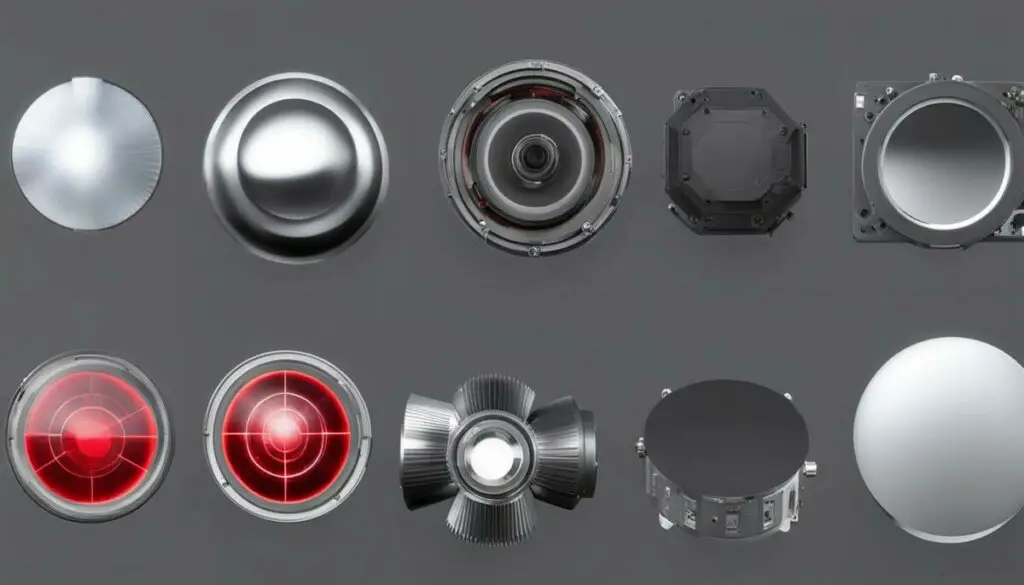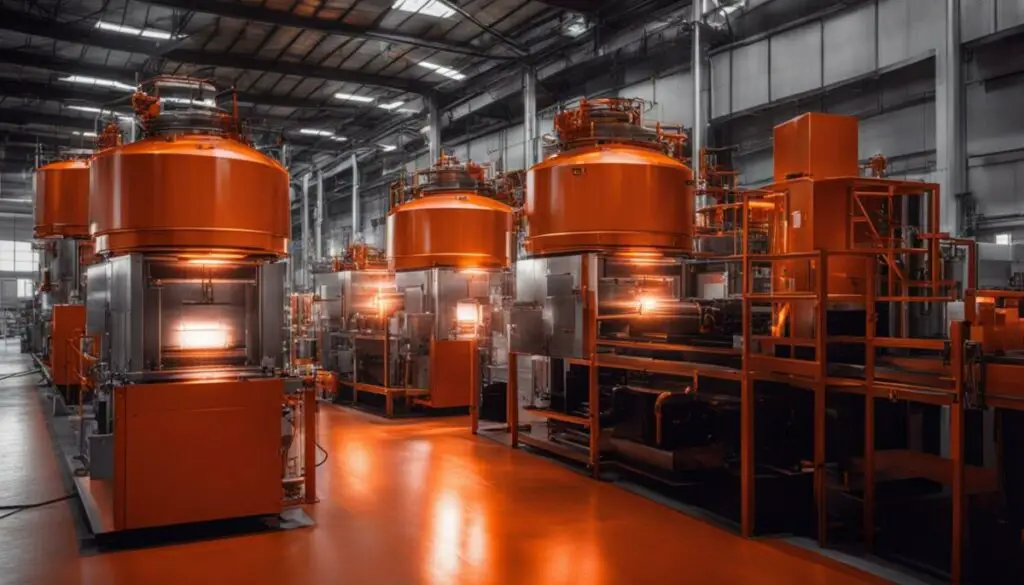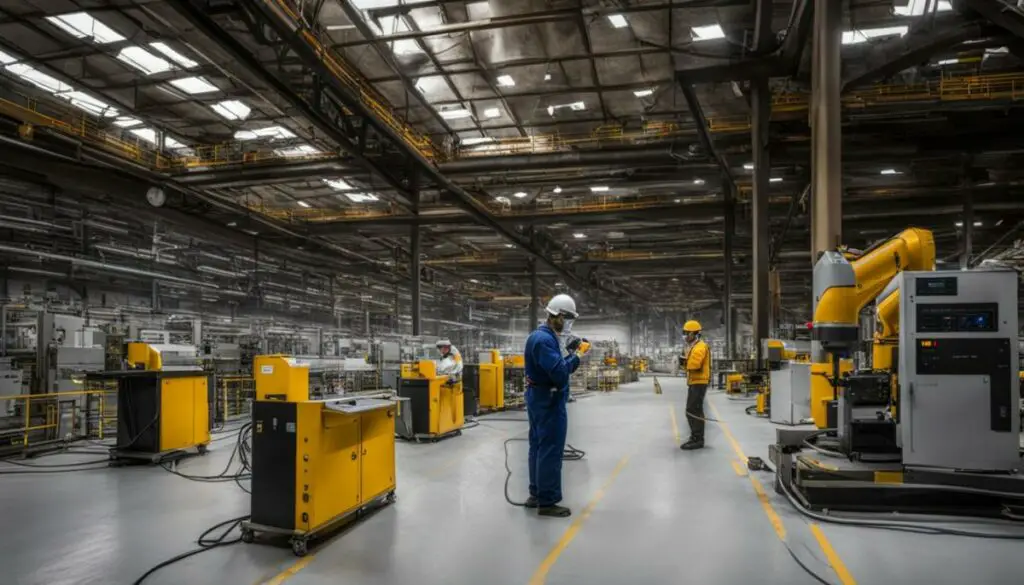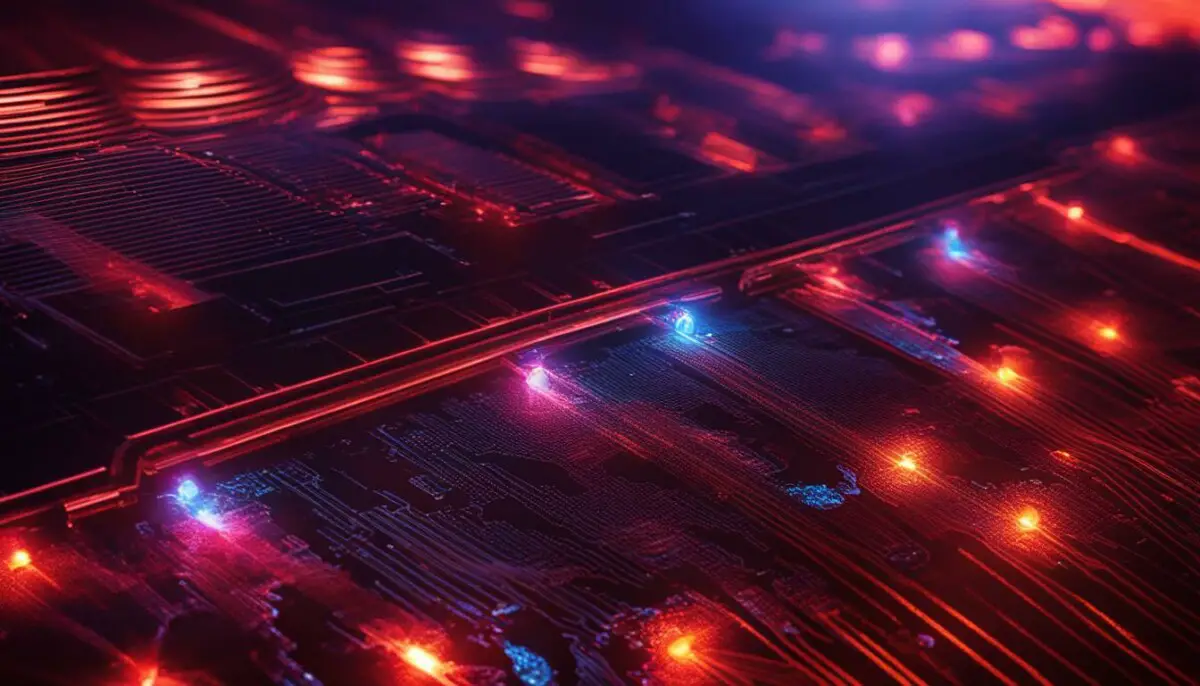Last Updated on 6 months by Francis
Have you ever wondered about the technology behind infrared emitters? What exactly is an infrared emitter and how is it used in various industries? In this section, we will explore the fundamental definition of an infrared emitter, its various uses and benefits in different applications, and shed light on the technology behind it.
An infrared emitter is a device that emits infrared radiation, which is a type of electromagnetic radiation with a longer wavelength than visible light. Infrared radiation is used for a wide range of applications, including heating, sensing, and communication. Infrared emitters are commonly used in industrial processes that require precise and efficient heating or drying, as well as in medical equipment for non-contact temperature measurement.
The technology behind infrared emitters is based on the principle of converting electrical energy into infrared radiation. This is achieved by using various types of materials such as tungsten, ceramic, or quartz, which are heated by an electrical current and emit infrared radiation.
The benefits of infrared emitters are numerous. They offer precise temperature control, are energy-efficient, and provide a non-contact method of heating or sensing. They are also used in a variety of industries, including manufacturing, automotive, aerospace, and healthcare.
Now that we’ve introduced the concept of infrared emitters, let’s explore the technology behind them and their various applications in more detail.
Contents
Key Takeaways:
- An infrared emitter is a device that emits infrared radiation for various applications.
- Infrared emitters are used in industrial processes, medical equipment, and communication technology.
- The technology behind infrared emitters involves converting electrical energy into infrared radiation using materials such as tungsten, ceramic, or quartz.
- The benefits of using infrared emitters include precise temperature control, energy efficiency, and non-contact operation.
- Infrared emitters are utilized in a wide range of industries, including manufacturing, automotive, aerospace, and healthcare.
Understanding Infrared Emitter Technology

Before diving into the different types of infrared emitters, it’s important to understand the technology behind them and their working principle. Infrared emitters are devices that emit electromagnetic radiation with wavelengths longer than visible light. They are commonly used in a variety of applications, including heating, drying, and sensing.
The working principle of infrared emitters is based on the conversion of electrical energy into radiant energy. When an electric current flows through the emitter, it generates heat, which in turn produces infrared radiation. This radiation is then directed towards the target object or material, where it is absorbed and converted into heat.
Infrared Emitter Technology
There are three main types of infrared emitters: ceramic, quartz, and metal. Ceramic emitters are the most common and are used in a wide range of applications. They are made of a ceramic element, usually aluminum oxide, and have a high emissivity and long lifespan. Quartz emitters are used in high-temperature applications, with a maximum operating temperature of up to 1400°C. They are made of fused quartz and have a high thermal shock resistance. Metal emitters are used in applications where high power output and rapid response time are required. They are made of a metal filament, usually tungsten or tantalum, and have a high radiant efficiency.
Infrared Emitter Advantages
One of the main advantages of using infrared emitters is their energy efficiency. They emit heat directly onto the target object or material, without heating the surrounding air. This results in significant energy savings compared to other heating methods, such as convection heating. Infrared emitters also provide precise control over the heat output, allowing for accurate temperature control and faster processing times. Another advantage is their non-contact operation, which reduces the risk of contamination or damage to the target object or material.
Infrared Emitter Working Principle
The working principle of infrared emitters is based on the conversion of electrical energy into radiant energy. When an electric current flows through the emitter, it generates heat, which in turn produces infrared radiation. This radiation is then directed towards the target object or material, where it is absorbed and converted into heat. The wavelength of the radiation depends on the temperature of the emitter, with higher temperatures producing shorter wavelengths and vice versa.
The wavelength range of infrared radiation is divided into three regions: near-infrared, mid-infrared, and far-infrared. Near-infrared radiation has a wavelength range of 0.7 to 1.3 microns and is used in sensing applications. Mid-infrared radiation has a wavelength range of 1.3 to 3 microns and is used in heating and drying applications. Far-infrared radiation has a wavelength range of 3 to 1000 microns and is used in medical and cosmetic applications.
Types of Infrared Emitters
There are several types of infrared emitters available, each with their own characteristics and features. Some of the most common types include:
- Ceramic infrared heaters
- Quartz infrared heaters
- Halogen infrared heaters
- Carbon fiber infrared heaters
- Shortwave infrared heaters
Each type of infrared emitter has its own advantages and disadvantages, depending on the specific application. Choosing the right type of emitter is essential to achieve the desired results.
Exploring Infrared Emitter Applications

Infrared emitters are widely used in various industries due to their unique properties and characteristics. Let’s take a closer look at some of the applications where infrared emitters play a critical role:
Manufacturing
Manufacturing processes often require precise and fast heating or drying of materials. Infrared emitters are an ideal solution for such applications as they can quickly and evenly heat up surfaces without contacting them, which reduces the risk of contamination and damage. They are used for heating, annealing, drying, curing, and other processes in industries such as automotive, electronics, pharmaceuticals, and textiles.
Food Processing
Infrared emitters are widely used in the food industry for cooking, drying, and baking. They provide precise and controlled heat, which ensures that food is cooked or dehydrated evenly and effectively. They are used in applications such as pizza ovens, commercial toasters, and food dehydrators.
Medical
Infrared emitters are used in medical applications such as physiotherapy, dermatology, and ophthalmology. They provide controlled heat, which can help alleviate pain and stimulate healing in patients suffering from various medical conditions. They are also used in infrared spectroscopy for medical analysis and diagnosis.
Automotive
Infrared emitters are used in the automotive industry for paint drying and curing. They provide fast and efficient heat, which ensures that paint is applied evenly and dried quickly. This reduces production time and costs, while also improving the quality and durability of the finished product.
Sensing and Monitoring
Infrared emitters are used for sensing and monitoring in various applications. They can detect temperature, distance, and movement, among other parameters. They are used in security systems, automation, and robotics, among other areas.
“Infrared emitters are versatile and offer unique benefits across different industries. They are energy-efficient, provide precise control, and can operate in non-contact mode, which reduces the risk of contamination and damage.”
In conclusion, infrared emitters have a wide range of applications in various industries, including manufacturing, food processing, medical, automotive, and sensing. They offer unique benefits such as precise and controlled heating, fast drying, and non-contact operation. As technology advances, we can expect to see even more innovative uses of infrared emitters in the future.
The Benefits of Infrared Emitters

Infrared emitters offer numerous benefits for various applications. Here are some of the advantages of using these devices:
| Benefit | Description |
|---|---|
| Energy Efficiency | Infrared emitters convert most of the energy they consume into heat. This makes them highly efficient and reduces energy waste. |
| Precise Control | With infrared emitters, it is possible to precisely control the intensity and direction of the emitted radiation. This allows for greater accuracy and consistency in various processes. |
| Non-Contact Operation | Infrared emitters can emit radiation without coming into contact with the target material or object. This is an advantage in applications where contact may be undesirable, such as in the food processing industry. |
| Safe Operation | Unlike other heating technologies, such as open flame or electric resistance, infrared emitters operate at low surface temperatures and pose minimal fire and electrical shock risks. |
| Fast Heating | Infrared emitters can heat surfaces and objects quickly, reducing processing times and increasing productivity. |
Overall, infrared emitters provide a range of benefits that make them a popular choice for various industries and applications.
Types of Infrared Emitters

There are various types of infrared emitters available in the market, each with its unique characteristics and features. The following are some of the most commonly used types:
| Type | Description |
|---|---|
| Quartz Tungsten Halogen | Uses a tungsten filament enclosed in a quartz capsule to emit infrared radiation. This type of emitter is known for its fast response time and precise control. |
| Ceramic Infrared Emitters | Consist of a ceramic plate coated with a metallic infrared-radiating layer. They are highly efficient and offer uniform heating over large surfaces. |
| Carbon Infrared Emitters | Carbon fiber elements are used to generate infrared radiation. They are energy-efficient, have a long lifespan and offer high heating power. |
| Gas-fired Infrared Emitters | Uses natural gas or propane to heat a ceramic or metal surface, which then emits infrared radiation. Often used in industrial processes due to their high energy output. |
Choosing the right type of infrared emitter depends on the specific application and requirements. Factors such as wavelength range, power output, and modulation need to be considered to ensure optimal performance and efficiency.
The Working Principle of Infrared Emitters

At its core, an infrared emitter works by generating and emitting infrared radiation that is then used for a variety of applications. The infrared radiation is produced by passing an electrical current through a filament or other material, which causes the atoms to vibrate and emit energy in the form of photons. These photons are then emitted as infrared radiation, which can be directed towards a specific target using a reflector or lens.
Infrared emitters operate on the principle of black body radiation, which describes the way in which all objects emit radiation based on their temperature. The higher the temperature of an object, the more radiation it emits, and the greater the proportion of that radiation that falls within the infrared spectrum.
The wavelength of the infrared radiation emitted by an infrared emitter can be adjusted depending on the specific material used and the voltage applied. This allows for precise control of the amount and type of radiation emitted, making infrared emitters highly versatile and adaptable for a wide range of applications.
One of the key advantages of infrared emitters is their ability to operate without contact, making them ideal for use in delicate or hazardous environments. Additionally, they offer fast response times and high levels of energy efficiency, making them an attractive option for industrial processes and other applications where time and energy are critical factors.
Example of Infrared Emitter Technology:
| Type of Infrared Emitter | Working Principle |
|---|---|
| Halogen Infrared Heater | Uses a tungsten filament surrounded by halogen to produce infrared radiation |
| Ceramic Infrared Heater | Uses a ceramic plate heated by an electrical current to produce infrared radiation |
| Quartz Infrared Heater | Uses a quartz tube filled with a halogen gas to produce infrared radiation |
Understanding the working principle of infrared emitters is crucial for selecting the right type of emitter for your specific needs and applications. By choosing the appropriate technology and wavelength range, you can ensure optimal performance and efficiency in your processes.
Industrial Uses of Infrared Emitters

One of the primary applications of infrared emitters is in industrial processes, where they provide a range of benefits. Let’s explore some of the most common uses of infrared emitters in industry.
Heating and Drying
Infrared emitters are widely used for heating and drying applications in different industries such as food processing, paper manufacturing, and textiles. Their ability to produce intense heat quickly and efficiently makes them ideal for these applications. Infrared radiation can penetrate deep into materials, allowing for uniform and precise heating that can significantly reduce processing time and improve quality.
Material Processing and Manufacturing
Infrared emitters are also commonly used in material processing and manufacturing. They can be used for curing coatings and adhesives, melting and welding plastics, and annealing glass. Infrared radiation can also be used for sterilization and disinfection in medical equipment and facilities. These processes benefit from the rapid response and control offered by infrared emitters, which ensure consistent production quality and reduce production time and costs.
Sensing and Detection
Infrared emitters are used extensively in sensing and detection applications, where they can detect and measure temperature, moisture, and other physical characteristics. Infrared sensors are used, for example, in automotive industry quality control to detect differences in paint finish.
Security and Surveillance
Infrared emitters are also used in security and surveillance applications, where they enable night vision and thermal imaging. These technologies are used in equipment such as security cameras, drones, and binoculars. Infrared radiation can penetrate smoke, fog, and other environmental conditions that would render visible light ineffective, leading to increased safety and security in different situations.
As you can see, infrared emitters have a wide range of industrial applications and offer many benefits. Their energy efficiency, precise control, and non-contact operation make them ideal for use in many different fields.
The Advantages of Infrared Emitters in Industry

Infrared emitters offer a wide range of advantages in industrial applications, making them a popular choice for various processes. Let’s explore some of the key benefits:
| Advantage | Description |
|---|---|
| Energy efficiency | Infrared emitters can deliver focused heat to a specific area, reducing energy waste and saving money on heating costs. |
| Increased productivity | With non-contact heating and drying, infrared emitters can speed up manufacturing processes and eliminate production downtime due to equipment maintenance or repair. |
| Precise process control | With the ability to precisely regulate the temperature and power output, infrared emitters ensure consistent quality and minimize the risk of errors or defects. |
| Cost-effective solutions | Compared to traditional heating methods, infrared emitters require less floor space, reduce material waste, and require less maintenance, resulting in cost savings for businesses. |
In addition to these benefits, infrared emitters offer improved safety compared to traditional heating methods. As they do not generate an open flame, there is a reduced risk of fire and explosion.
Overall, the advantages of infrared emitters make them a valuable asset for many industrial processes, improving efficiency, reducing costs, and ensuring consistent quality.
Key Considerations When Choosing Infrared Emitters
If you’re considering using infrared emitters for your specific needs, there are several key factors to keep in mind. These factors can help ensure that you select the right type of infrared emitter for your application and achieve optimal results.
Wavelength Range
The wavelength range of an infrared emitter is one of the most important factors to consider. Different applications may require different wavelengths for optimal performance. For example, short-wavelength infrared (SWIR) emitters are ideal for sensing and monitoring applications, while mid-wavelength infrared (MWIR) and long-wavelength infrared (LWIR) emitters are better suited for heating and drying processes.
Power Output
When selecting an infrared emitter, it’s essential to consider the required power output. The power output typically depends on the size of the target object and the distance between the emitter and the object. A higher power output can provide faster heating, but it may also consume more energy and generate more heat.
Modulation
Modulation refers to the ability to control the output power of an infrared emitter continuously. This feature can be useful for applications that require precise temperature control or for reducing energy consumption. Some emitters offer on/off modulation, while others offer continuous modulation.
| Infrared Emitter Type | Modulation |
|---|---|
| Incandescent | On/Off |
| Halogen | On/Off or Continuous |
| LED | Continuous |
| Laser | Continuous |
Compatibility with Other Equipment
It’s crucial to consider the compatibility of an infrared emitter with other equipment in your system. Different emitters may require specific power supplies, controllers, or mounting accessories. Make sure to check the compatibility of each component before making a purchase.
Manufacturer Reputation
The reputation of the manufacturer is another important factor to keep in mind. Choose a manufacturer with a track record of producing high-quality, reliable products with good customer support and warranty options.
By considering these key factors, you can select the right infrared emitter for your specific needs, ensuring optimal performance and results.
Future Trends in Infrared Emitter Technology
As with any technology, infrared emitter technology is constantly evolving and improving. In the future, we can expect to see several exciting advancements that will push the boundaries of what is possible with these devices.
Increased Efficiency
One of the primary areas of focus for infrared emitter technology is improving efficiency. As energy costs continue to rise, companies are looking for ways to save money by reducing their energy usage. Infrared emitters are already more efficient than many traditional heating methods, but future advancements will make them even more so. This will be achieved through the use of new materials and designs that generate more heat with less energy.
Miniaturization
Another trend we can expect to see in the future is the miniaturization of infrared emitters. As devices become smaller and more powerful, they will be able to fit into a wider range of applications. This will make them more versatile and easier to integrate into existing systems.
Integration with Other Technologies
Infrared emitter technology is already widely used in many industries, but in the future, we can expect to see even more integration with other technologies. For example, infrared emitters could be combined with sensors or artificial intelligence to create more advanced heating or drying systems. This will increase the efficiency and precision of these devices, leading to better results and cost savings.
Expanded Applications
The versatility of infrared emitters means that they have the potential to be used in a wide range of applications. In the future, we can expect to see these devices used in new and innovative ways. For example, they could be used for medical treatments or even in space exploration. As technology advances, the possibilities for infrared emitters will continue to expand.
Overall, the future of infrared emitter technology is bright. With continued advancements and improvements, these devices will become even more valuable in a wide range of industries and applications.
Conclusion
As we conclude our exploration of infrared emitters, it is evident that these devices play a critical role in various industries. From manufacturing to sensing and heating, infrared emitters offer many benefits, including energy efficiency, precise control, and cost-effectiveness.
We have learned about the different types of infrared emitters available in the market and their working principles. It is essential to consider aspects such as wavelength range, power output, modulation, and compatibility with other equipment when choosing an infrared emitter for your specific needs.
Looking ahead, the future of infrared emitter technology appears promising, with potential developments such as efficiency, miniaturization, and integration with other technologies. As such, it is vital to stay up-to-date with the latest advancements in this field.
In conclusion, infrared emitters are versatile and powerful tools that have revolutionized various industries’ processes and functions. We hope this article has provided you with a better understanding of their potential applications and importance.
FAQ
What is an infrared emitter?
An infrared emitter is a device that emits infrared radiation, which is a form of electromagnetic radiation with longer wavelengths than visible light. It is commonly used in various applications for heating, drying, sensing, and communication purposes.
What are the different types of infrared emitters?
There are several types of infrared emitters available, including incandescent emitters, tungsten halogen emitters, ceramic emitters, and carbon emitters. Each type has its own characteristics and is suitable for different applications.
What are the benefits of using infrared emitters?
Using infrared emitters offers several benefits, such as energy efficiency, precise control, non-contact operation, and compatibility with a wide range of materials. They are also cost-effective and environmentally friendly.
Where are infrared emitters commonly used?
Infrared emitters are used in various industries, including manufacturing, food processing, automotive, healthcare, and aerospace. They are employed for tasks such as heating, drying, curing, printing, and temperature sensing.
How do infrared emitters work?
Infrared emitters work by converting electrical energy into infrared radiation. They contain a heating element, usually made of tungsten or ceramic, which emits the infrared radiation when heated. This radiation can then be absorbed by objects or used for specific applications.
What factors should I consider when choosing an infrared emitter?
When selecting an infrared emitter, important factors to consider include the wavelength range, power output, modulation capabilities, compatibility with other equipment, and the specific requirements of your application.
What are the future trends in infrared emitter technology?
The future of infrared emitter technology is expected to focus on improved efficiency, miniaturization, integration with other technologies, and expanded applications. Advancements in materials and manufacturing techniques will drive innovation in this field.









